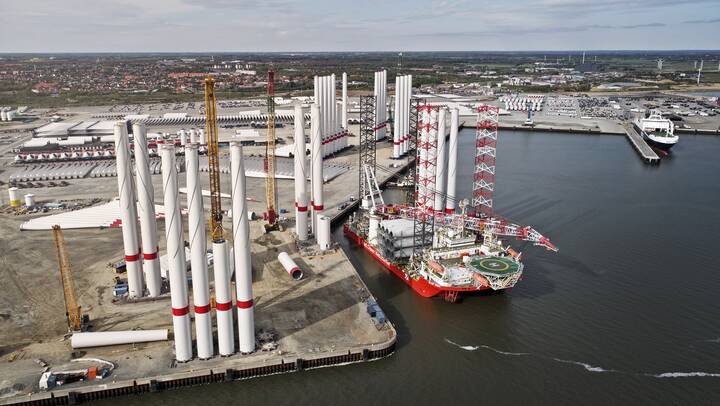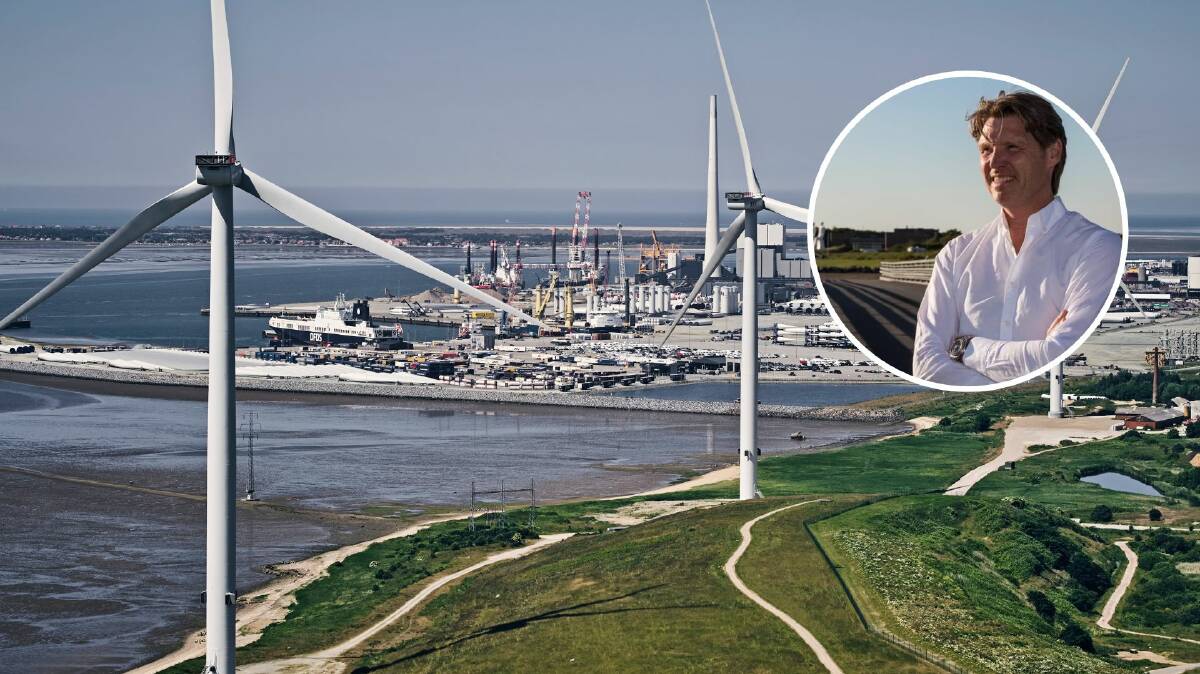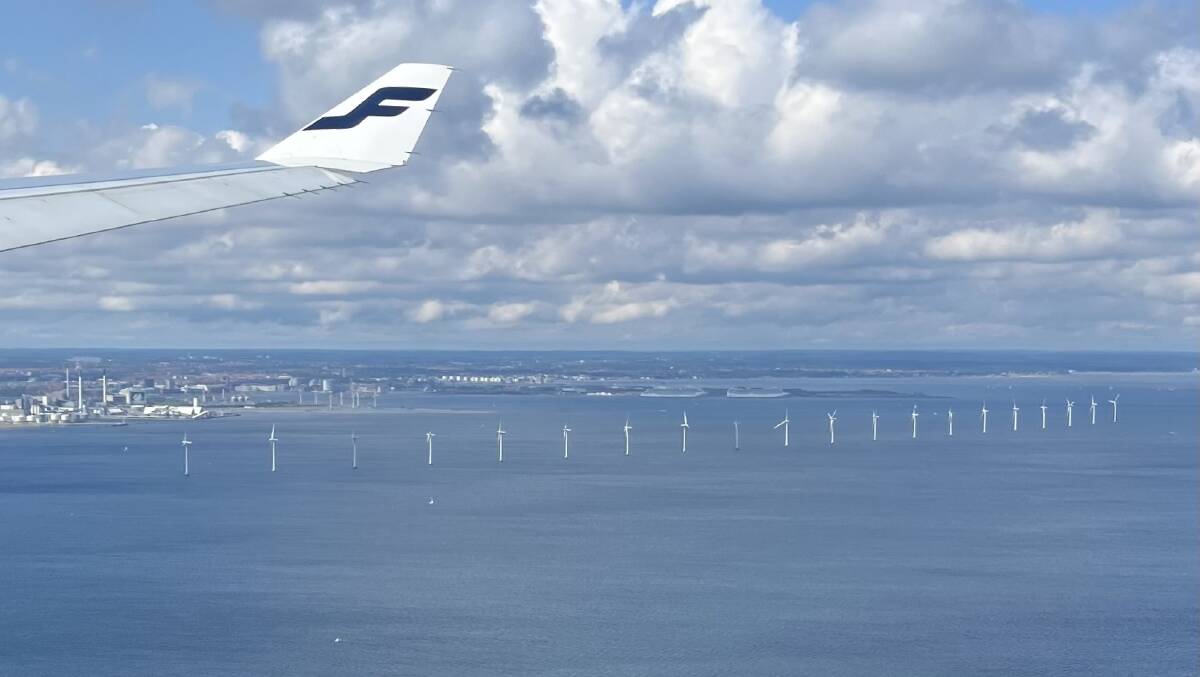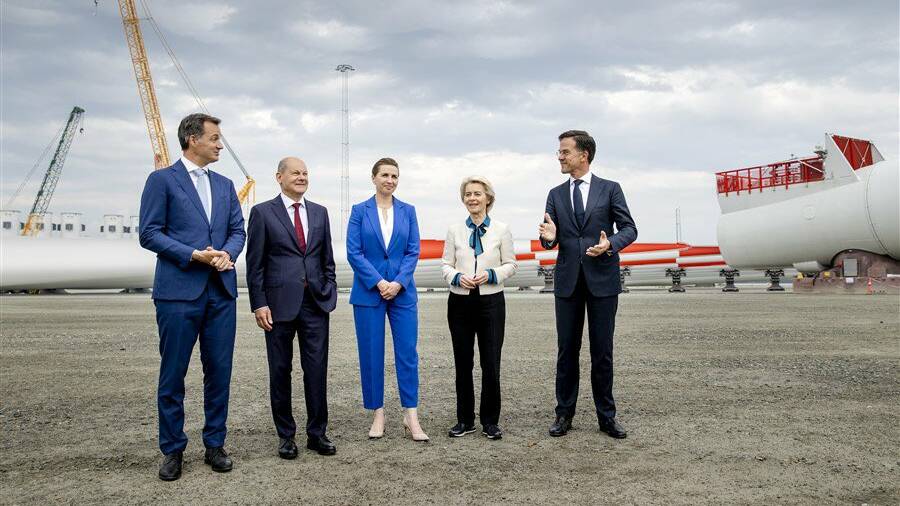
Business reporter Connor Pearce travelled to Denmark to find out what a future with wind farms looks like for the Illawarra. He starts his series of stories by looking at the port of Esbjerg.
Subscribe now for unlimited access.
or signup to continue reading
In just his lifetime, Jakob Lykke has seen the port of Esbjerg transform twice.
When he first worked the docks at the age of 15, the harbour was teeming with fishing boats that would return laden with herring mackerel.
Today, the 20 metre masts of the trawlers have been replaced by wind turbine towers ten times their height, assembled on the quayside that last saw a fish auction 20 years ago.
In the meantime, Mr Lykke - a local councillor who leads the Esbjerg branch of Denmark's largest union 3F - has seen the port on the western coast of Denmark become a hub for the offshore oil and gas industry.
"A lot of our members have been working in the fishing industry, but also oil and gas, and now they're working in the wind industry," the 55 year old said.

As the Illawarra begins to contemplate what an offshore wind industry could look like, Esbjerg offers an example of what our own transition could be, but as Mr Lykke points out, the transition from fishing town to centre of a multibillion dollar industry wasn't always assured.
"I've seen too many times around the North Sea, towns that had a rich history and that don't exist anymore."
How Esbjerg became a wind power centre
While it might seem unthinkable now, it was not too long ago that the Illawarra faced a similarly bleak future.
In 2009 amid the global economic crisis and a downturn in the steel industry a group representing business, government and workers formed to put green industry at the heart of the Illawarra's transformation.
While the group was wound up in 2013, as appetite for climate change dissipated at the federal level after the 2013 election, on the other side of the globe, the wind industry began a massive scale up, to the point where wind alone produces enough energy to power the entire country of Denmark for days at a time.
But this didn't happen by accident. A concerted effort by unionists such as Mr Lykke, businesses and the community generated a way out of Denmark's energy crisis in the 1970s and laid the groundwork for a place like Esbjerg to grow from a few docks serving a fishing port to a landside area stretching across a million square metres, dedicated to the installation of offshore wind in the North Sea.
The story begins in the midst of the 1970s oil crisis, as the price of imported oil to Denmark skyrocketed. The country then generated most of its power from oil-based power stations, and energy was rationed to the extent that citizens were prohibited from driving on Sundays, turning highways into playgrounds.
Unlike neighbours Germany and Sweden that turned to nuclear energy, a concerted environmental movement pushed Denmark to what was then a novelty - wind turbines. After a period of development in the 1980s, the first offshore wind farms were up and running in the 1990s, partly financed by local co-operatives and owned by citizens and municipalities.

This ownership structure allowed for small scale projects to get up and running, providing a testing ground for the industry to trial offshore wind farms. At that time, when the offshore oil and gas industry was dominant in Esbjerg, Mr Lykke could see that this industry was not going to provide long-term, widespread employment, just as fishing had earlier collapsed.
"We could see at that moment, there is a new situation with the green transition," Mr Lykke said. "In Esbjerg we are used to not getting any help from the government, so we had to do it ourselves."
Skilling up a new workforce
Mr Lykke's union and other workers organisations jointly worked with the dominant businesses in the town to develop an agreement. Unlike the often adversarial relationship between unions and businesses in the English-speaking world, the Danish model of workplace organising promotes collaboration in industry, with unions and businesses jointly delivering training, agreements upon wages and working conditions and even unemployment benefits.
"The companies come to me and say, Jakob, we need 100 or 200 people who can do this or this and I make sure that [my members] get the education so they can do it."
At the same time, in the early 2000s the Danish government was establishing a regulatory framework for offshore wind and setting out subsidies for wind energy projects. The first tender for an offshore wind project was released in 2004.
A year later, an energy company was chosen to deliver a 200 megawatt offshore wind farm, about 30 kilometres from the port of Esbjerg.
An industry driven by government
For the subsequent 20 years, the Danish government would lead the push into wind energy, setting goals for the industry and providing transparent targets for offshore wind, getting to the point where for the first time an offshore wind project will pay the government to deliver power into the market, Simon Hansen, offshore wind advisor to the Danish Energy Agency explained.
"We try to encourage the industry, the market, that we are a secure place to put offshore wind, we want to go down that route," he said.
"Long term planning, and setting ambitious and reliable targets has been very important in Denmark."
In Australia, only Victoria has set a specific target for offshore wind generation, with the Commonwealth and NSW governments so far declining to put a figure on the amount of power to come from sea-based turbines.

With 2.3 gigawatts of offshore wind currently installed in Denmark, in May 2022 prime ministers from Denmark, Belgium and the Netherlands and the German chancellor signed the Esbjerg declaration, setting out the ambition to turn the North Sea into the "green power plant of Europe".
The joint declaration targets 65 gigawatts of offshore capacity by 2030 and 150GW by 2050. The National Electricity Market, which covers Australia's east coast has a total electricity generation capacity of roughly 55GW.
What's next for Esbjerg
With Esbjerg responsible for 80 per cent of installed offshore wind capacity in Europe already, port director Dennis Jul Pedersen said the terminal is preparing for a massive capacity upgrade.
"Today we have booked over 12 GW to be installed from here over the next six to seven years," he said. "Three times more than we had ever done before."
Achieving this after three decades is a massive and challenging task for Denmark and its neighbours. For Australia, which has considerable ambitions of its own, the challenge will be to undergo an Esbjerg transformation on its own, but Mr Lykke has one word of advice.
"If you don't work together, you won't be able to solve it."
The Mercury travelled with the assistance of the Danish Embassy, Canberra.
Our news app has had a makeover, making it faster and giving you access to even more great content. Download The Illawarra Mercury news app in the Apple Store and Google Play


